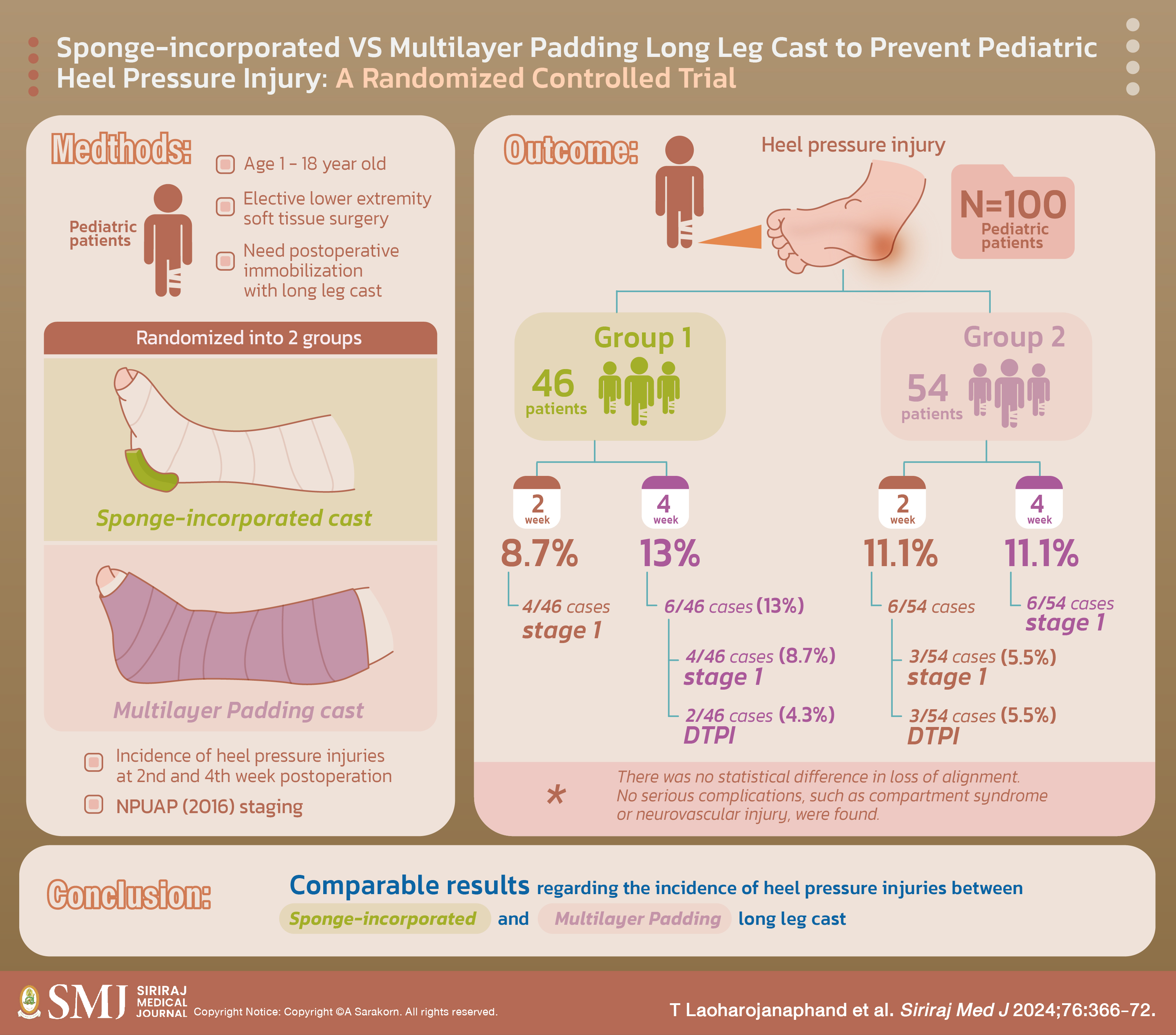Sponge-incorporated VS Multilayer Padding Long Leg Cast to Prevent Pediatric Heel Pressure Injury: A Randomized Controlled Trial
Sponge-incorporated Cast to Prevent Pressure Injury
DOI:
https://doi.org/10.33192/smj.v76i6.266370Keywords:
long leg cast, cast complications, sponge-incorporated cast, pressure injuryAbstract
Objective: To measure and compare the incidence of cast-related pressure injuries at the heel between sponge-incorporated long leg cast and multilayer padding cast following orthopedic lower extremity surgery.
Materials and Methods: Patients aged 1 to 18 years who were scheduled for elective lower extremity soft tissue surgery were recruited. They were equally randomized into two groups: sponge padding cast (Group 1) and multilayer padding cast (Group 2). A multilayer padding cast, consisting of five layers of Webril®, was applied to the heel and bony prominence areas. At the 2nd and 4th weeks postoperatively, cast-related heel pressure injuries were evaluated using the 2016 National Pressure Ulcer Advisory Panel (NPUAP) staging system. Changes in alignment and other complications were also recorded.
Results: 100 patients were recruited. At two weeks postoperatively, the incidence of cast-related heel pressure injuries in Group 1 was 4/46 cases (8.7%), with all cases being stage 1. In Group 2, there were 6/54 cases (11.1%), with 3 cases in stage 1 and 3 cases in deep tissue pressure injury (p=0.479). At four weeks postoperatively, Group 1 had 6/46 cases (13%), with 4/46 cases (8.7%) being stage 1 and 2/46 cases (4.3%) being deep tissue pressure injuries. Group 2 had 6/54 cases (11.1%) (p>0.99), with all cases being stage 1. There was no statistical difference in loss of alignment. No serious complications, such as compartment syndrome or neurovascular injury, were found.
Conclusion: The incidence of cast-related heel pressure injury was comparable between sponge padding cast and a multilayer cotton padding cast.
References
Difazio RL, Harris M, Feldman L, Mahan ST. Reducing the Incidence of Cast-related Skin Complications in Children Treated With Cast Immobilization. J Pediatr Orthop. 2017;37:526-31.
Murgai RR, Compton E, Patel AR, Ryan D, Kay RM. Foam Padding in Postoperative Lower Extremity Casting: An Inexpensive Way to Protect Patients. J Pediatr Orthop. 2018;38:e470-e4.
Forni C, Loro L, Tremosini M, Mini S, Pignotti E, Bigoni O, et al. Use of polyurethane foam inside plaster casts to prevent the onset of heel sores in the population at risk. A controlled clinical study. J Clin Nurs. 2011;20:675-80.
Jittivilai T. Heel Alert. J Thai orthop Nurs Soc. 2015;20:675-80.
Shirley ED, Maguire KJ, Mantica AL, Kruse RW. Alternatives to Traditional Cast Immobilization in Pediatric Patients. J Am Acad Orthop Surg. 2020;28:e20-e7.
Baharestani MM, Ratliff CR. Pressure ulcers in neonates and children: an NPUAP white paper. Adv Skin Wound Care. 2007;20:208-20.
Goudie EB, Gendics C, Lantis JC, 2nd. Multimodal therapy as an algorithm to limb salvage in diabetic patients with large heel ulcers. Int Wound J. 2012;9:132-8.
Malkoun M, Huber J, Huber D. A comparative assessment of interface pressures generated by four surgical theatre heel pressure ulcer prophylactics. Int Wound J. 2012;9:259-63.
Hsu RY, Lareau CR, Born CT. Novel posterior splinting technique to avoid heel ulcers. Orthopedics. 2013;36:31-2.
Edsberg LE, Black JM, Goldberg M, McNichol L, Moore L, Sieggreen M. Revised National Pressure Ulcer Advisory Panel Pressure Injury Staging System: Revised Pressure Injury Staging System. J Wound Ostomy Continence Nurs. 2016;43:585-97.
Cho HM, Ha JS, Seo JW, Lee HJ, Kim SD, Lee H, et al. Conservative treatment using a sponge cast for transfer fractures in nursing home patients. Clin Interv Aging. 2019;14:1361-9.
Nguyen S, McDowell M, Schlechter J. Casting: Pearls and pitfalls learned while caring for children's fractures. World J Orthop. 2016;7:539-45.
Seehausen DA, Kay RM, Ryan DD, Skaggs DL. Foam padding in casts accommodates soft tissue swelling and provides circumferential strength after fixation of supracondylar humerus fractures. J Pediatr Orthop. 2015;35:24-7.

Published
How to Cite
License
Copyright (c) 2024 Siriraj Medical Journal

This work is licensed under a Creative Commons Attribution-NonCommercial-NoDerivatives 4.0 International License.
Authors who publish with this journal agree to the following conditions:
Copyright Transfer
In submitting a manuscript, the authors acknowledge that the work will become the copyrighted property of Siriraj Medical Journal upon publication.
License
Articles are licensed under a Creative Commons Attribution-NonCommercial-NoDerivatives 4.0 International License (CC BY-NC-ND 4.0). This license allows for the sharing of the work for non-commercial purposes with proper attribution to the authors and the journal. However, it does not permit modifications or the creation of derivative works.
Sharing and Access
Authors are encouraged to share their article on their personal or institutional websites and through other non-commercial platforms. Doing so can increase readership and citations.














